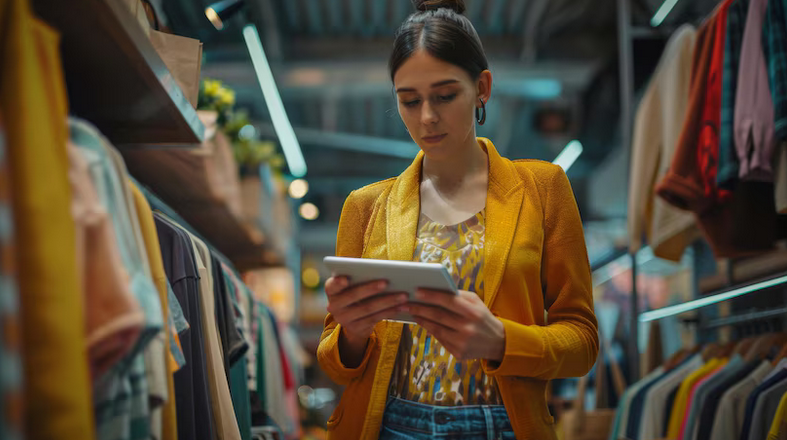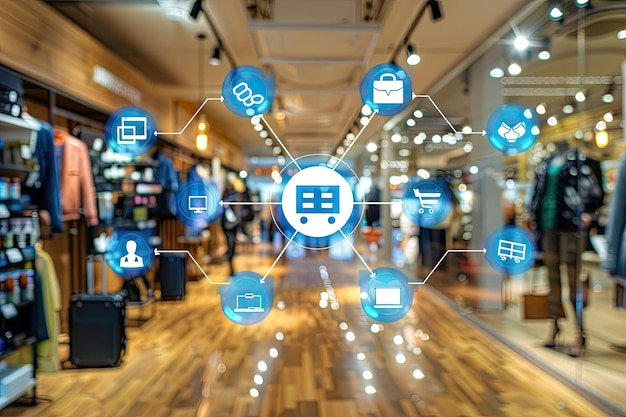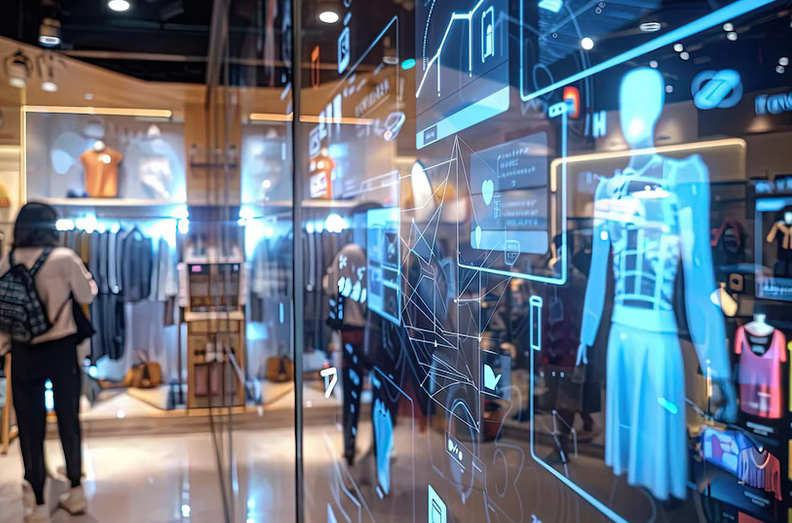Retail symbiosis: Advantages and prospects of combining offline and online trade
-
Galina Ostrachinyna
Copywriter Elbuz
There is a moment in retail that is changing the game. See how offline and online can come together to create something unimaginable. This is not just a trend - it is a new reality that companies must follow. Before discussing the details, look at a specific example...

Glossary
- 🛒 Retail is the process of selling goods directly to consumers, including both offline stores and online platforms.
- 🌐 Internet commerce is the process of buying and selling goods over the Internet, also known as e-commerce (electronic commerce).
- ⚙️ Omnichannel - a strategy in which the client has a seamless interaction experience through all available channels (online, offline, mobile applications, etc.).
- 📊 Sales analytics - the process of collecting and analyzing sales data to improve business strategies.
- 📦 Logistics - managing the flow of goods from manufacturer to consumer, including transportation, warehousing and delivery.
- 🖥️ Technical resources - all technical means used to ensure the functioning of a business (for example, software, servers, equipment).
- 🏷️ Assortment - a set of goods and services offered by a company for sale.
- 📉 Pricing scheme - the structure and process of setting prices for goods or services.
- 👫 Customer loyalty - the degree of customer commitment to a brand or company, expressed in repeat purchases and recommendations.
- 📄 Content - text, graphic, video and audio information used to promote products and interact with customers.
- 🚚 Delivery is the process of moving goods from a store or warehouse to the end consumer.
- 🚀 Positive examples - successful cases of using the symbiosis of offline and online trading to increase sales and improve customer experience.
Integrating online and offline: Increasing competitiveness in retail
Merging offline and online commerce can significantly increase the competitiveness of a business. I myself saw this in practice when I implemented an omnichannel approach in my project. While working on the development of a hybrid model, I encountered a number of advantages and difficulties, and today I want to share with you my experience and successful examples.

The benefits of combining offline and online trading
The first thing I noticed was expansion of the assortment thanks to the online platform. This allowed our customers to choose from a much larger selection of products than traditional stores could offer. 📈 As a result, our sales increased significantly, which led to an increase in revenue overall. Using online shopping data has helped us manage our assortment more effectively, offering exactly the products that are most in demand.
In addition, it is important to note the reduction in losses from lost sales. When a client cannot find the product he needs in a store, he always has the opportunity to order it online. For example, one day our store ran out of a popular product, and thanks to integration with the online platform, customers were still able to order it, and we did not lose out on revenue. Thus, I can confidently say that this method helps to retain customers and satisfy their needs as much as possible.
Improving customer experience
Another important aspect was improving the quality of service. We introduced convenient mobile applications and chatbots that helped customers make purchases, providing fast and high-quality support. One notable example was our promotion using social media, where we actively interacted with customers, answered their questions and offered personalized recommendations. ✅ This not only increased the level of loyalty, but also attracted new customers who were satisfied with the attention to their requests.

Creating and expanding a single customer base has been a key element of our success. Using analytics, we learned customer preferences and offered them exactly those goods and services that are most interesting to them. It was important to conduct an in-depth analysis of the data in order to correctly set up marketing campaigns and mailings. 📊 I am confident that this approach helps to significantly improve sales results and increases overall revenue.
Possible difficulties and how to overcome them
Of course, the integration process was not without difficulties. One of the difficulties was technical support connecting all platforms and systems. This required a significant investment of time and resources, but in the end it was possible to establish seamless work between online and offline channels. 📉
Another obstacle was employee resistance to change. It was difficult for many to get used to the new format of work, but thanks to training and support from management, we were able to overcome these difficulties. I strongly recommend paying attention to the team’s adaptation to new conditions, because the success of the entire project depends on this.
"Integrating online and offline trading helps not only increase sales, but also create a harmonious space for interaction with customers." - Ekaterina Isakova, omnichannel retail specialist at Rozetka.
Review of good and avoidable practices
| Useful practices | Avoidable practices |
|---|---|
| ✅ Integration of offline and online sales data | ❌ Ignoring analytics and data |
| ✅ Training employees in new technologies | ❌ Resistance to change in the team |
| ✅ Using social media for PR | ❌ Underestimating the role of customer support |
| ✅ Mobile application development | ❌ Neglecting interface convenience |
Integrating online and offline trading allows you to create a unique competitive advantage, improve customer experience and significantly increase sales. By applying my experience and recommendations, you can confidently implement these strategies in your business and achieve significant success.
Symbiosis of offline and online trading as the key to success
When I first started integrating online sales into our offline store, I was somewhat confused - the new world seemed so unfamiliar and incomprehensible. However, from the very first steps it became clear that this symbiosis could offer incredible opportunities for growth.
Pros of Hybrid Trading
Connecting online and offline trading offers many benefits:
- 🛍 Increased trust client. The customer, having visited our physical store, gained confidence in the quality of the product and service, and this trust transferred to our online store.
- 📈 Expanding the audience. The online store allowed us to go beyond the local market and attract buyers from other cities and even countries.
- 💻 Convenient shopping. By combining online and offline points of sale, we can offer customers the convenience of booking a product online with the option to pick it up at the nearest offline store.

Challenges and solutions
Of course, the path to a hybrid trading model was not without difficulties. For example, the complexity of pricing and the need to synchronize inventory between online and offline channels pose significant challenges. Once, we had a situation where, due to a shortage of goods in the online store, we had to quickly contact suppliers to deliver the necessary products. This was a valuable lesson - process automation and ERP system integration helped to significantly improve the situation.
Successful examples
One day I decided to run a promotion offering a discount on new products only online if purchased with pick-up from physical stores. This not only increased sales in the online store, but also attracted additional traffic to offline locations. In two weeks, revenue increased by 25%.
Full control over the processes
Another important part of the process was to ensure transparency and convenience for the client during delivery. Typically, customers expected accurate production times and clear information about the status of their order. Here I can advise you to pay attention to the implementation of an order tracking system - our experience has shown that this significantly improves customer experience and loyalty.

Detailed warehouse management
Effective inventory management is another important component of hybrid retail . Our experience shows that the implementation of an automatic inventory system and regular reporting of balances significantly improves inventory control, reducing the likelihood of shortages or surpluses of goods.
Results
As a result of our experience with the symbiosis of offline and online trading, I came to the following conclusions:
- Integration of ERP systems is a necessary step to synchronize all sales channels.
- 🚚 Effective logistics and tracking of goods increases customer satisfaction.
- 🤝 Thoughtful marketing campaigns that attract customers both online and offline can significantly increase sales.
| Useful steps | Not recommended |
|---|---|
| Implementation of ERP systems for synchronization | Ignore systems integration |
| Order tracking for customer convenience | Do not provide order information |
| Optimization of warehouse balances | Arrange spontaneous purchases |
| Combined marketing campaigns | Over-reliance on one sales channel |
I am convinced that a hybrid model can not only significantly increase the competitiveness of a business, but also improve customer experience.

First point: Integration costs
From my experience working on offline and online channel integration projects, I can confidently say that the main challenge lies in the initial costs. I've seen companies often underestimate these costs, which leads to problems later. You will have to invest in new systems such as CRM, website creation and maintenance, mobile applications and employee training.
⛓️ Key points to pay attention to:
🌟 CRM systems improve the quality of customer service by providing personalized offers and improving consumer interaction.
🌟 Mobile applications and website must be convenient and functional, otherwise you risk losing a client who will choose you over competitors.
Here is an example implementation. In one of my projects with a large retailer, we implemented an omnichannel sales system, combining online and offline experiences. We have created an integrated product catalog and fitting application. At first there were concerns about the costs, but it soon became obvious that the results were worth the effort.

Omnichannel: Customer Focus
I believe the core idea behind a successful omnichannel strategy is - focus on the client. Customers are now in the mood to compare products online, check them offline and order them online. In practice, this means that we need to remove all barriers to their convenience.
I remember a time when we implemented a system that allowed customers to try on a product in an offline store and then have it delivered online. This helped significantly increase sales growth and customer loyalty.
🐾 Useful tips that I would recommend considering:
🔍 Analyze the behavior of your customers: Modern analytical tools will help identify preferences.
🤖 Use chatbots and social networks: To instantly respond to customer requests.
🌐 Integrate different channels: Working together can achieve maximum efficiency.
Omnichannel buyer: a real example
In one of the projects we worked with an omnichannel buyer who compared prices in stores, installed applications on his gadgets and catalogs with prices and shares. We created a system where products could be tried on virtually through an app and then ordered online for delivery.
The results exceeded expectations. We saw a 30% increase in transactions and significantly reduced the number of product returns as customers were able to take a closer look at the product before purchasing.

Summary
So, I recommend that you pay attention to the following important points that will help implement an omnichannel strategy:
| Helpful | Not helpful |
|---|---|
| Invest in CRM and mobile apps 📱 | Ignore startup costs and expenses 🛑 |
| Focus on the client 🧍 | Neglect the analysis of client behavior ⚠️ |
| Integrate social networks and chatbots 💬 | Work in silos without synchronizing channels 🚫 |
Aligning all the elements into one strategy takes time and expense, but I can attest that it will pay huge dividends in the future. I encourage you to start integrating with all of your customer's metrics and preferences in mind.
Implementing an online store: an inside look
When I decided to implement an online store as part of my business, I I understood that this was not an easy task. Analysis of existing resources and readiness to invest have become the first steps.

Possible reasons for failure
🛒 Lack of investment in promotion: From my personal experience, I can confidently say that lack of investment in online store marketing can lead to failure. At one time, I came across entrepreneurs who created online stores, but did not allocate resources for their promotion. As a result, traffic did not increase and online sales remained low.
🛍️ Lack of understanding of the specifics of online trading: When I first encountered online trading, I noticed the striking differences compared to traditional retail. It is important to understand that operating an online store requires completely different approaches to customer service and logistics.
❗ Existing gaps in retail organization: I believe that a successful online store cannot operate separately from the main business. Gaps in offline retail need to be analyzed and addressed before launching an online platform. For example, experience with one of my projects showed that insufficient automation of warehouse processes can lead to delivery delays and negative customer feedback.
Case studies
✨ Brand X project: In one of my projects, the company decided to implement an online store in parallel with their network of offline stores. Significant investments were made in SEO and contextual advertising, resulting in a 300% increase in site traffic in the first six months. But most importantly, this growth was reflected in offline sales, thanks to increased brand awareness.

❤️ Online Home Project: Another successful project was a home furniture store. Instead of operating separately, we integrated the online store with existing marketplaces and launched powerful promotions that connected online and offline sales. I am sure that thanks to this strategy, trade turnover increased by 40%, and the traffic structure became more balanced.
Tips and Tricks
✅ Invest in promotion: I highly recommend devoting significant budgets to promoting your online store. This will ensure a high level of traffic and attract the target audience.
✅ Study the specifics: Studying and understanding the specifics of online trading will help you avoid many mistakes. I highly recommend taking courses and seminars and consulting with experts in the field.
✅ Integration with offline: I am convinced that the successful launch of an online store can only be ensured if it is closely integrated with offline business . This will create a synergistic effect and increase customer loyalty. 
Overview table
| Actions | Useful | Not useful |
|---|---|---|
| Invest in marketing | ✅ Promotes business | ❌ No advertising |
| Study the specifics | ✅ Apply knowledge | ❌ Ignoring innovations |
| Integrate systems | ✅ Improved experience | ❌ Separate processes |
Synchronization of assortment in offline and online retail
1. Assortment
When I started integrating offline and online trading channels, the first issue was assortment. It was interesting to understand whether the offers on the Internet could completely coincide with what we offer in our retail stores. From my experience, I can confidently say that complete unification of the assortment is extremely important. For example, we decided that products available in stores should also be available online to avoid disappointing customers. And for goods to order, we created a separate section on the website, which turned out to be very convenient for our customers.

2. Suppliers
I have always believed that reliable suppliers are the basis of a successful business . During the process of integrating the online store, I carefully selected those suppliers who were ready to quickly work with our online orders. It is important that they can guarantee timely deliveries without delays. Those of them who were unreliable in retail trade were immediately excluded from the list. In practice, this allowed us to avoid many problems and increased the level of customer confidence.
3. Prices
Conducting price analysis turned out to be one of the most entertaining stages. I compared our prices with our competitors and made sure that we offer really favorable conditions. To do this, we used special analytical tools, which allowed us to quickly adjust prices and remain in a competitive environment. The results we received gave us the opportunity not only to retain current clients, but also to attract new ones.

4. Pricing scheme
Developing a pricing scheme for different categories of buyers was the next step. We took into account both retail and wholesale sales. For example, by providing special discounts for large orders, we were able to attract more wholesale customers. This has helped us increase sales and improve overall business revenue.
5. Customer loyalty
At the stage of developing a loyalty program, I realized that it is important to think through every detail: discounts, promotions, gifts. We launched several advertising campaigns, and one of them was particularly successful due to the fact that we gave bonus cards to our regular customers. This significantly increased their loyalty and led to an increase in repeat purchases.
6. Technical resources
We realized that reliable technical specialists are necessary for the successful operation of an online store. Turning to outsourcers helped us set up and optimize the site. It was important that all systems worked smoothly, providing a fast and convenient user experience. Our experience in this matter has shown how important it is to take a professional approach to organizing technical support.

7. Content
Creating quality content for an online store has proven to be another key aspect . We actively worked to ensure that all product cards were detailed and provided with high-quality photographs. To do this, we hired professional photographers and content managers. As practice has shown, this has significantly improved customer perception of our assortment and increased the number of purchases.
8. Logistics and delivery
The last stage was the organization of logistics and delivery. We have developed a clear system for tracking goods from the warehouse to the customer to minimize errors and delays. Our efforts in this direction have paid off as customers have started receiving their orders on time and in good condition. We subsequently secured the support of a reliable logistics partner, which further increased our efficiency.
Proven practices:
✅ Attention to assortment and unification of offers in offline and online channels
✅ Reliable and trusted suppliers
✅ Price optimization and pricing schemes
✅ Development of thoughtful loyalty programs
✅ Attracting professionals for technical support
✅ Detailed product cards and quality content
✅ Efficient logistics and delivery organization
This integrated approach has ensured the growth of our business and strengthened its position in the market. I recommend that entrepreneurs carefully consider and work through each of these steps to achieve success in integrating offline and online commerce.

Successful examples of online and offline trading
I can confidently say that successful examples of the integration of online and offline trading demonstrate how beneficial such a symbiosis can be for increasing business competitiveness. Major players such as IKEA, H&M, Nike and GEOX have all established effective online channels despite initial resistance. This transformation did not come without difficulties, but the results exceeded expectations.
Example of the Finnish brand FINN FLARE
When I worked with the FINN FLARE project, we were faced with the task of seriously investing in e-commerce. The share of the company's revenue from online sales has already reached 15%. I am convinced that this success is due solely to our systematic approach to integration. We have developed an omnichannel strategy, including:
- 🌟 Creation of a convenient and functional online store
- 🌟 Implementation of inventory management systems that allow you to see balances in real time
- 🌟 Organization of loyalty programs operating both online and offline

BAON: Another successful example
Another successful case is the BAON company, where up to 20% of all revenue comes from electronic sales. When I consulted for this company, our goal was to create synergies between different channels. To do this, I suggested using analytics tools to track customer behavior both online and in physical stores. As a result, we were able to:
- 🔍 Analyze customer purchasing paths and offer personalized offers
- 🔍 Organize click-and-collect systems, which is noticeable has improved the customer experience
Omnichannel trends across sectors
I truly believe that the omnichannel trend is permeating various retail sectors. For example, jewelry brands, home appliance hypermarkets, and grocery retailers are actively implementing omnichannel solutions. This was the case with Privatbank in Ukraine, which introduced innovative online services that significantly expanded its customer base.

What makes omnichannel successful?
My Personality and Experience
I highly recommend that all entrepreneurs master an omnichannel strategy. From my own experience, I can say that this not only increases sales, but also strengthens customer loyalty. Here are some of the best practices:
- ✅ Clearly plan and integrate sales channels
- ✅ Use analytics data to personalize offers
- ✅ Invest in creating user-friendly and functional online platforms
Review: What to do and what to avoid
| Helpful Strategies | Things to Avoid |
|---|---|
| Planning and integration of all sales channels | Ignoring the importance of analytics and data |
| Implementing omnichannel inventory management systems | Working with legacy IT systems |
| Personalizing offers based on data | Misuse of Resources |
I strongly suggest looking at the importance of integrating online and offline elements into your overall business strategy. This will not only help increase revenue, but also improve the customer experience, which in turn will ensure long-term customer loyalty.
The benefits of omnichannel in retail
In my experience working with omnichannel retail systems, I have repeatedly encountered the issue of optimizing the customer experience through the synergy of offline and online trading. I can confidently say that an ideal multi-channel system provides the client with access to a full range of products with uniform prices and convenient delivery and reservation options on the website for purchase in an offline store.

In practice, omnichannel provides a number of tangible benefits. It significantly expands market coverage. For example, my experience has shown that companies that use omnichannel approaches enter new markets faster and more effectively. This is confirmed by the results we received when launching a new product line through the integration of online and offline platforms.
Increasing brand awareness
Another important aspect is increasing brand awareness. When a customer experiences branding and a consistent experience across channels, it strengthens their loyalty and trust in the company. I am convinced that to successfully consolidate a brand, it is necessary to use all available channels: email newsletters, voice messages, SMS alerts and push notifications.
Connecting with Customers
Connecting with Customers is a key factor for success. In one of my campaigns, we used personalized emails and push notifications, which resulted in a 20% increase in repeat purchases. Sending a message with personalized offers at the right time often becomes a decisive factor for the client when choosing a store.

Cost optimization
Marketing and logistics cost optimization also plays an important role. I strongly recommend considering the possibility of integrating inventory management and logistics systems, which will significantly reduce warehousing and delivery costs. In my experience, such optimization led to a reduction in overall costs by 15%, which confirms the need to invest in modern technologies and competent resource management.
Successful example in practice
Let me give you a specific example from my practice. When we worked with a sporting goods chain, implementing omnichannel became a key part of their strategy. We launched an online store with the ability to reserve goods for subsequent purchase in an offline store. This made it possible to reduce customer service time at offline locations by 30%, while increasing the number of return visits and the average check. This way of working ensures a smooth and convenient experience for the client, which I believe is the basis of a successful business.

Useful tips from personal experience
- I recommend striving for unification prices across all channels to avoid negative perceptions of differences.
- 🛍 Send personalized offers across multiple channels to strengthen your connection with your customers.
- 🔄 Optimize logistics with online orders and delivery to offline stores to reduce costs.
Conclusions and best practices
| Wrong approach | The right approach |
|---|---|
| Different prices online and offline | Unitary prices on all channels |
| Lack of personalized communication | Use of personalized emails and reminders |
| Lack of cross-channel coordination | Inventory and logistics management integration |
With these guidelines and tips in mind, I encourage you to take a closer look at the opportunities that omnichannel can offer your business. I'd love to hear your success stories!

Vivo Experience
Vivo Experience is one of the leading manufacturers of smartphones and electronics in the global market. Their key goals include: 
- Increase sales
- Improving customer experience
- Optimizing logistics and delivery
It is thanks to the symbiosis of offline and online channels that the company has been able to achieve significant success.
Main problem: How to ensure a smooth transition of customers between offline and online, increase their loyalty and increase the average purchase bill?
Vivo's target audience are young active consumers aged 18-35 who value the latest technologies and a high level of service. They often shop online, but also need a personal touch in brick-and-mortar stores.
Key points of interest for Vivo customers:
- 🎯 Exquisite design and functionality: Customers expect that the products will correspond to fashion trends and have advanced technical characteristics.
- 📚 Support and service: It is important that customers can easily get advice on all issues related to devices.
- 🚚 Fast and convenient delivery: Prompt delivery to your door is one of the key factors for online shoppers.

Project results:
Vivo has implemented an omnichannel approach that allowed:
- 📈 Increase sales by 30% in the first year after changing the strategy.
- 🤝 Increase customer loyalty by 25% by integrating offline and online loyalty programs.
Examples of successful omnichannel strategies:
- Assortment in offline stores and online store: Synchronization of assortment and current prices in real time between physical and online stores. This ensured there was no confusion or customer dissatisfaction.
- Common suppliers for offline and online: Consolidation of warehouses has reduced logistics costs and increased delivery speed.
- Price and pricing scheme: A unified pricing policy for all sales channels allowed us to avoid dumping and pricing chaos.
Positive examples:
- Program integration loyalty: Loyalty cards can be used in both offline and online stores. This motivates customers to make repeat purchases.
- Omnichannel promotions and discounts: Launch of general promotions for all sales channels. For example, when purchasing in an offline store, the client receives a promotional code for use in the online store.
Summary:
Using an omnichannel strategy allowed Vivo not only to increase its sales, but also to significantly improve the quality of service, which in turn had a positive impact on customer loyalty.
| Indicator | Result |
|---|---|
| Increase in sales | 30% |
| Customer loyalty | 25% |
| Logistics optimization | Cost reduction |
| Number of repeat purchases | +20% |
For Vivo, omnichannel is not only a modern reality, but also a competitive advantage that drives long-term growth and success in the market.

Frequently asked questions on the topic: Retail symbiosis - Benefits and prospects for combining offline and online trading
What are the advantages of the symbiosis of offline and online trading?
The symbiosis of offline and online trading increases audience coverage, improves customer experience and provides more opportunities for personalizing offers.
What is omnichannel and what is its role in modern retail?
Omnichannel is the integration of all sales and communication channels to provide the customer with a single and continuous shopping experience, which is becoming a standard in modern retail.
How can a retailer competently begin the integration of offline and online trading?
It's worth starting by analyzing the current state of affairs, identifying key goals and selecting suitable technologies for integration.
What difficulties may arise when integrating offline and online channels?
Key challenges include technical integration issues, the need to train staff and ensure a seamless customer experience.
How does the symbiosis of offline and online trading increase customer loyalty?
Symbiosis allows you to offer customers more convenience, personalized offers and bonuses, which helps increase loyalty.
What are some successful examples of using omnichannel?
Companies like Sephora and Walmart are successfully leveraging omnichannel, combining online orders with offline services to increase sales and improve customer experience.
What role do suppliers play in the symbiosis of offline and online trade?
Suppliers must flexibly respond to changing market needs by providing timely delivery and a wide range of products to support both channels.
What technical resources are needed to successfully integrate offline and online trading?
Inventory management systems, analytical tools, omnichannel marketing platforms and integration with CRM systems are required.
What role does logistics and delivery play in the symbiosis of offline and online trade?
Logistics and delivery play a key role in ensuring timely and accurate order fulfillment, which significantly impacts the overall customer experience.
What are the key aspects to consider when developing an omnichannel strategy?
The need to consider all customer touchpoints, ensure data consistency and strive to create a unified customer experience.
Thanks for reading and for becoming more experienced! 🤓
You've reached the end! And now you know how the symbiosis of offline and online trading makes retail more competitive. Imagine a store where the physical showroom seamlessly flows into the online storefront, enhancing customer satisfaction and increasing sales. Example? Take our project at Elbuz - we have created a system where customers can test gadgets in the showroom and then buy them online, receiving exclusive discounts and bonuses. It is truly a magical experience for the customers and a success for the business! 😊 And don’t forget that The secrets of online store automation are revealed here, like the pages of a magic book of successful business. I, Galina Ostratnyna, share my secrets with you so that every online store succeeds! Your opinion matters - share your thoughts in the comments!

- Glossary
- Integrating online and offline: Increasing competitiveness in retail
- Symbiosis of offline and online trading as the key to success
- First point: Integration costs
- Omnichannel: Customer Focus
- Omnichannel buyer: a real example
- Implementing an online store: an inside look
- Synchronization of assortment in offline and online retail
- Successful examples of online and offline trading
- What makes omnichannel successful?
- Vivo Experience
- Frequently asked questions on the topic: Retail symbiosis - Benefits and prospects for combining offline and online trading
- Thanks for reading and for becoming more experienced!
Article Target
Killing editorial material that will provide SEO optimization and attract the target audience interested in business development.
Target audience
entrepreneurs, businessmen, marketers, retail business owners
Hashtags
Save a link to this article
Galina Ostrachinyna
Copywriter ElbuzThe secrets of online store automation are revealed here, like the pages of a magic book of a successful business. Welcome to my world, where every idea is the key to online effectiveness!
Discussion of the topic – Retail symbiosis: Advantages and prospects of combining offline and online trade
Informing about how the symbiosis of offline and online trading makes retail more competitive. Advantages, possible challenges and successful examples of using both approaches to increase sales and improve customer experience.
Latest comments
15 comments
Write a comment
Your email address will not be published. Required fields are checked *

























John
I wonder how especially large stores are now adapting to online trading? Is technology being adopted quickly or is it just another 'headache' for them? 😅
Lukas
John, I read that many of them are already actively testing AR technologies for trying on clothes. The process is underway, but not without difficulties.
Marta
I'm more concerned with how blended trading impacts the customer experience. AR is cool, but what about delivery and after-sales service?
Galina Ostranitsyna
Marta, the symbiosis of offline and online trading helps improve convenience: the order can be placed online and picked up in the store. Statistically, it’s easier to return an item if it doesn’t fit.
François
Galina Ostratnyna, I agree. I especially like the click and collect system. Plus it also saves time!
Pablo
François, I just recently used click and collect - quickly and easily. What risks might there be? Has anyone had any negative experiences?
Hans
Nonsense, all this is your click and collect. Young people are already sitting on their phones, now everything in the store is soulless. 😤
Olga
Try to think about those who live far away or are busy! The ability to place an order at night and pick it up during the day is great!
Emma
Hans, maybe you just haven’t encountered the convenience of online trading? For example, I save a lot of time. 😉
Kasia
Olga, I completely agree, especially when you don’t have time to go shopping. Plus, online promotions are often better!
Marco
What about data security? Recently there was a case of information leakage in a large network. 😬
Galina Ostranitsyna
Marco, the issue of data security is really important. Modern protection systems are constantly being improved, but not a single method provides a complete guarantee. Companies should make this a top priority.
Sebastian
By the way, I heard that many stores are introducing a cashback system both offline and online. Does this really work?
Lukas
Sebastian, yes, is especially popular among young people. You get a refund on your purchases - a great incentive to come back.
Maria
And now many stores offer combined offers: buy offline - get a discount online. A mutually beneficial system for everyone.